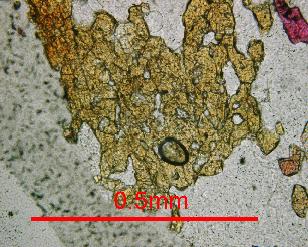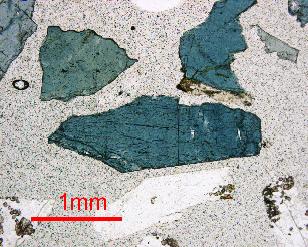 |
 |
|
Mineral under plane polarized light
|
again but now rotated 90 degrees clockwise
|
1. Look at the glaucophane slide BH250-7. The pleochroic formula for glaucophane
is: X=colorless, Y=pale violet, Z=deep blue. Knowing that glaucophane is a negative
mineral, what two colors would you look for if you were trying to find a grain
properly oriented to give you a Bxa figure? For a Bxo? For a flash figure? And
for a centered optic axis figure? Look at the slide to see if you are correct.
What is the 2V for glaucophane?
2. Look at a slide containing biotite BH-250-14 . Look up the pleochroic formula and see if you can determine the orientation of individual grains like you did in #1. (This one's just for practice)
3. Look at the slides of biotite, glaucophane, olivine, and hornblende. Look
at these minerals and make a table of important characteristics. Record only
things you observe.
Plechroism is demonstrated here in these pictures of....
 |
 |
|
Mineral under plane polarized light
|
again but now rotated 90 degrees clockwise
|
 |
 |
|
Mineral under plane polarized light
|
again but now rotated 90 degrees clockwise
|
The above pictures were taken from Professor Bereket Haileab's Powerpoint presentation entitled Lecture 1.
To see this lecture go to The Lectures page and click on Lecture 1.
|
|
|
|
biotite under plane polarized light
|
the same biotite rotated 90 degrees counter clockwise
|
www.gly.bris.ac.uk/www/ teach/opmin/mins.html